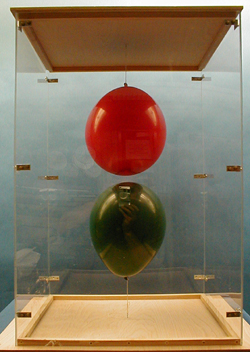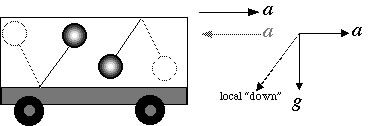Demos: 1E-02 Balloon Paradox

The buoyant force in a particular reference frame always acts in the direction opposite that of the "local gravity." This local gravity is determined by combining vectorially the direction of g and the direction of the acceleration. For example, if a box is accelerated horizontally to the right, the direction of "g" in the frame of the box is downward and toward the left. So air trapped inside this box will have its density gradient upward and toward the right. A helium balloon suspended from the bottom of the box will thus float "upward" along that direction and an air-filled balloon will hang "downward," i.e. downward and to the left.
 Directions: Two balloons, one inflated with helium, the other with ordinary air, are suspended from the bottom and top of the "cage," respectively. A rope is attached at either end of the cage.
Directions: Two balloons, one inflated with helium, the other with ordinary air, are suspended from the bottom and top of the "cage," respectively. A rope is attached at either end of the cage.
Suggestions for Presentation: If the cart is accelerated from rest toward the right, the balloons will assume positions shown. If the cart is brought to rest quickly, the balloons will hang or lean as shown by the dashed lines. Ask the students what would happen if the box were moved in a horizontal circular path. (See also Demo 1E - 3).
Applications: Students can be encouraged to try this in their cars, especially with a helium-filled balloon. As the car accelerates from rest, the helium-filled balloon moves forward rather than backward, as expected.
Last Updated: Nov 30, 2023 11:25 AM